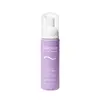What's inside
What's inside
 Key Ingredients
Key Ingredients

 Benefits
Benefits

 Concerns
Concerns

 Ingredients Side-by-side
Ingredients Side-by-side

Water
Skin ConditioningPolyimide-1
Aloe Barbadensis Leaf Juice
Skin ConditioningPyrus Malus Fruit Extract
Skin ConditioningHelianthus Annuus Sprout Extract
Skin ConditioningCaesalpinia Spinosa Fruit Extract
Skin ProtectingGlycerin
HumectantTocopherol
AntioxidantPanthenol
Skin ConditioningPolysorbate 20
EmulsifyingPolyquaternium-73
Decyl Glucoside
CleansingVp/Dmapa Acrylates Copolymer
Propylene Glycol
HumectantCetrimonium Chloride
AntimicrobialDisodium EDTA
Parfum
MaskingEthylhexylglycerin
Skin ConditioningPhenoxyethanol
PreservativeCitric Acid
BufferingCaprylyl Glycol
EmollientSodium Benzoate
MaskingBenzyl Salicylate
PerfumingAmyl Cinnamal
PerfumingCitral
PerfumingLinalool
PerfumingLimonene
PerfumingHexyl Cinnamal
PerfumingWater, Polyimide-1, Aloe Barbadensis Leaf Juice, Pyrus Malus Fruit Extract, Helianthus Annuus Sprout Extract, Caesalpinia Spinosa Fruit Extract, Glycerin, Tocopherol, Panthenol, Polysorbate 20, Polyquaternium-73, Decyl Glucoside, Vp/Dmapa Acrylates Copolymer, Propylene Glycol, Cetrimonium Chloride, Disodium EDTA, Parfum, Ethylhexylglycerin, Phenoxyethanol, Citric Acid, Caprylyl Glycol, Sodium Benzoate, Benzyl Salicylate, Amyl Cinnamal, Citral, Linalool, Limonene, Hexyl Cinnamal
Aloe Barbadensis Leaf Juice Powder
Skin ConditioningWater
Skin ConditioningPolyquaternium-55
Cocamidopropyl Betaine
CleansingHeptyl Glucoside
Hydroxypropyltrimonium Hydrolyzed Corn Starch
Hydrolyzed Adansonia Digitata Seed Extract
Caprylhydroxamic Acid
Caprylyl Glycol
EmollientGlycerin
HumectantSodium Phytate
Citric Acid
BufferingAnthemis Nobilis Flower Oil
MaskingCananga Odorata Flower Oil
MaskingCanarium Commune Gum Oil
MaskingCaprylic/Capric Triglyceride
MaskingCitrus Aurantium Dulcis Flower Oil
AstringentGeranium Maculatum Oil
MaskingJasminum Officinale Flower/Leaf Extract
MaskingJuniperus Virginiana Oil
MaskingLitsea Cubeba Fruit Oil
MaskingRosa Damascena Extract
MaskingRosa Damascena Flower Oil
MaskingTanacetum Annuum Flower/Leaf/Stem Oil
MaskingTocopheryl Acetate
AntioxidantAloe Barbadensis Leaf Juice Powder, Water, Polyquaternium-55, Cocamidopropyl Betaine, Heptyl Glucoside, Hydroxypropyltrimonium Hydrolyzed Corn Starch, Hydrolyzed Adansonia Digitata Seed Extract, Caprylhydroxamic Acid, Caprylyl Glycol, Glycerin, Sodium Phytate, Citric Acid, Anthemis Nobilis Flower Oil, Cananga Odorata Flower Oil, Canarium Commune Gum Oil, Caprylic/Capric Triglyceride, Citrus Aurantium Dulcis Flower Oil, Geranium Maculatum Oil, Jasminum Officinale Flower/Leaf Extract, Juniperus Virginiana Oil, Litsea Cubeba Fruit Oil, Rosa Damascena Extract, Rosa Damascena Flower Oil, Tanacetum Annuum Flower/Leaf/Stem Oil, Tocopheryl Acetate
Alternatives
Ingredients Explained
These ingredients are found in both products.
Ingredients higher up in an ingredient list are typically present in a larger amount.
Caprylyl Glycol is a humectant and emollient, meaning it attracts and preserves moisture.
It is a common ingredient in many products, especially those designed to hydrate skin. The primary benefits are retaining moisture, skin softening, and promoting a healthy skin barrier.
Though Caprylyl Glycol is an alcohol derived from fatty acids, it is not the kind that can dry out skin.
This ingredient is also used as a preservative to extend the life of products. It has slight antimicrobial properties.
Learn more about Caprylyl GlycolCitric Acid is an alpha hydroxy acid (AHA) naturally found in citrus fruits like oranges, lemons, and limes.
Like other AHAs, citric acid can exfoliate skin by breaking down the bonds that hold dead skin cells together. This helps reveal smoother and brighter skin underneath.
However, this exfoliating effect only happens at high concentrations (20%) which can be hard to find in cosmetic products.
Due to this, citric acid is usually included in small amounts as a pH adjuster. This helps keep products slightly more acidic and compatible with skin's natural pH.
In skincare formulas, citric acid can:
While it can provide some skin benefits, research shows lactic acid and glycolic acid are generally more effective and less irritating exfoliants.
Most citric acid used in skincare today is made by fermenting sugars (usually from molasses). This synthetic version is identical to the natural citrus form but easier to stabilize and use in formulations.
Read more about some other popular AHA's here:
Learn more about Citric AcidGlycerin is already naturally found in your skin. It helps moisturize and protect your skin.
A study from 2016 found glycerin to be more effective as a humectant than AHAs and hyaluronic acid.
As a humectant, it helps the skin stay hydrated by pulling moisture to your skin. The low molecular weight of glycerin allows it to pull moisture into the deeper layers of your skin.
Hydrated skin improves your skin barrier; Your skin barrier helps protect against irritants and bacteria.
Glycerin has also been found to have antimicrobial and antiviral properties. Due to these properties, glycerin is often used in wound and burn treatments.
In cosmetics, glycerin is usually derived from plants such as soybean or palm. However, it can also be sourced from animals, such as tallow or animal fat.
This ingredient is organic, colorless, odorless, and non-toxic.
Glycerin is the name for this ingredient in American English. British English uses Glycerol/Glycerine.
Learn more about GlycerinWater. It's the most common cosmetic ingredient of all. You'll usually see it at the top of ingredient lists, meaning that it makes up the largest part of the product.
So why is it so popular? Water most often acts as a solvent - this means that it helps dissolve other ingredients into the formulation.
You'll also recognize water as that liquid we all need to stay alive. If you see this, drink a glass of water. Stay hydrated!
Learn more about Water